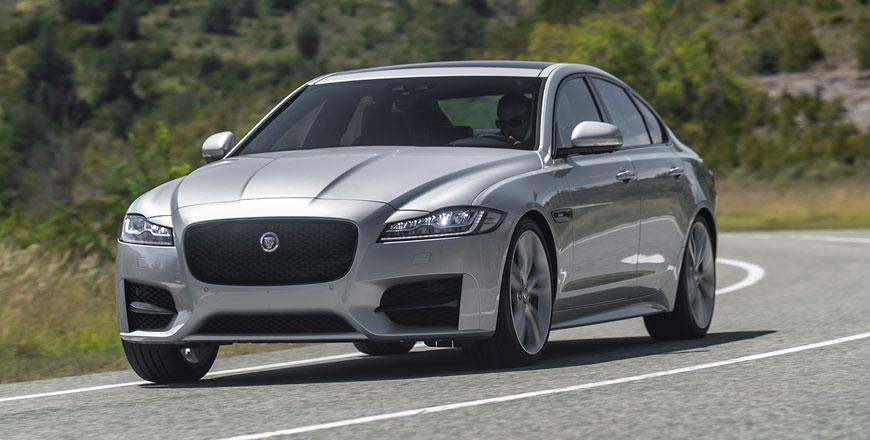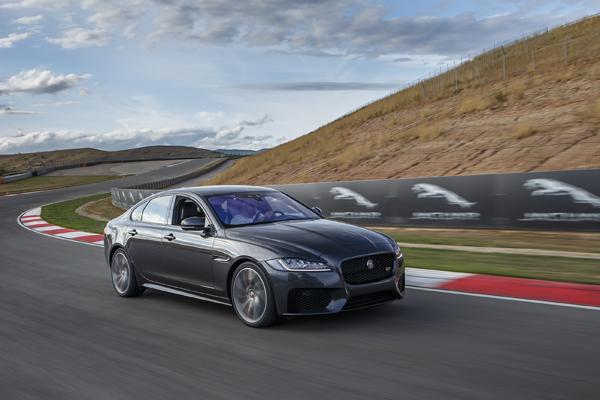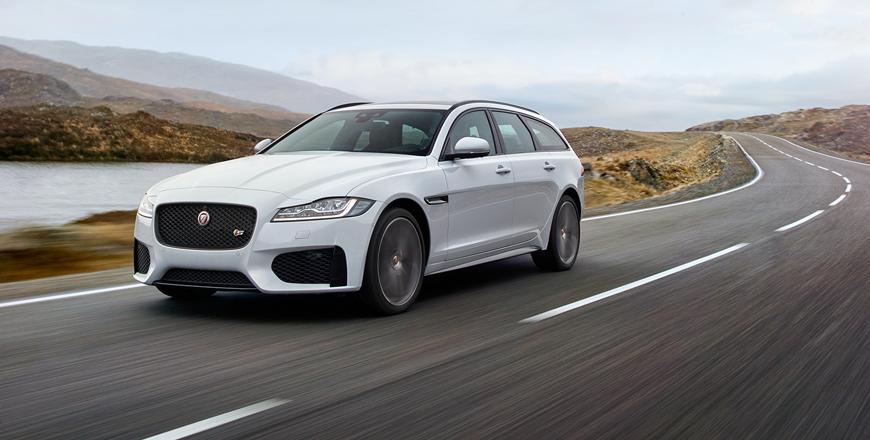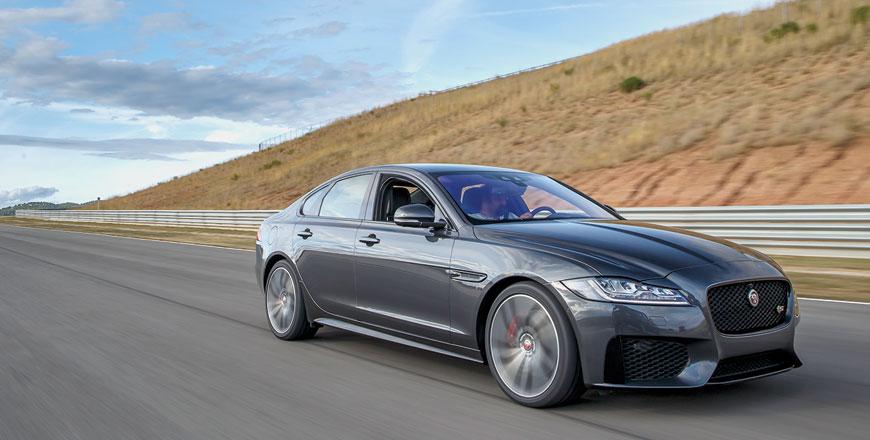You are here
High-tech executive evolution
By Ghaith Madadha - Aug 31,2015 - Last updated at Aug 31,2015

Photo courtesy of Jaguar
Launched globally in recent weeks, the second generation Jaguar XF picks up where its predecessor left off. Crisp and contemporary, the XF changed Jaguar’s design ethos from traditional to futuristic — while maintaining its sense of heritage — when first launched in 2007. The new XF is, however, a more high-tech machine that combines classy design and rewarding yet refined driving characteristics.
Smooth, sporty, seductively styled and now built on a stiff and light aluminium frame, the new XF’s design is evolutionary, while its driver and dynamic assistance and infotainment technology suite is advanced and user-friendly. A more focused on its mid-size executive saloon, the new XF is powered by several familiar but improved engines, and Jaguar Land Rover’s all-new 2-litre turbo-diesel Ingenium engine.
Architecture and aesthetics
Evolutionary in aesthetic, the new XF’s design is, however, noticeably more defined and chiselled, with sharper lines, more sculpted surfacing and a greater emphasis on width and road presence. Starting with a wider, better refined, more upright and snoutier more jutting honeycomb grille, the XF also receives bigger and deeper side intakes pinched inwards at the centre and a expanding, road-hugging lower intake.
A more noticeably muscular stepped bonnet and power bulge are complemented by sharper “J” LED headlight motifs. Side views include sharper character lines, prominent sweeping waistline ridge and strong rear haunches. Short front overhang and an elegantly long boot lend a classic cabin-rear look. A lower waistline looks classier and improves visibility, while its rakish roofline has been finessed for a 27mm rear headroom improvement.
Built with 75 per cent aluminium architecture, the new XF is 28 per cent stiffer and 11 per cent lighter, which translates into a weight loss of up to 190kg and improved handling precision and ride refinement. Bucking the trend for ever-larger successor models, the new XF is marginally smaller, with 7mm length and 3mm height reductions. However, a 51mm longer wheelbase provides more rear legroom and improved ride stability.
Punchy and perky oil burner
Offered with a range of supercharged petrol and turbocharged diesel V6 engines, the new XF range starts with Jaguar’s much anticipated and highly efficient turbocharged 2-litre 4-cylinder Ingenium engine, as driven during its global launch event in northern Spain. Available only as a turbo-diesel at present, a petrol-powered Ingenium engine is expected to replace the XF’s Ford Ecoboost-derived 2-litre turbocharged petrol engine in the near future.
Efficient, abundant and refined the XF Ingenium turbo-diesel is the sort of contemporary and clean engine that Jordanians deserve and makes a strong case for the introduction of diesel passenger cars, which are currently not permitted. Mated to a smooth and concise shifting 8-speed automatic gearbox driving the rear wheels, the XF 2.0 Diesel driven returns frugal hybrid-rivalling 4.3l/100km combined fuel consumption and low 114g/km CO2 emissions.
Quick spooling and with little of the turbo-lag associated with turbo-diesels, the XF 2.0 Diesel is perky and punchy for an oil burner. Developing a massive 318lb/ft torque throughout 1750-2500rpm, the XF’s muscular mid-range ability allows for effortless versatility and responses at highway driving. Building up to its maximum 177BHP by 4000rpm, the XF feels eager, while performance includes 8.1-second 0-100km/h acceleration and a 229km/h top speed.
Supple and sporty
Built on stiff and light aluminium architecture, and with low unsprung mass and 50:50 weight distribution the XF’s sound dynamic basis is aided by fluent yet honed suspension that allows for both ride comfort and composed handling. With double wishbone front and integral-link rear suspension, the XF’s more versatile suspension tuning enables a smoother more supple ride and better
roadholding, crisper cornering responses and tauter body control.
With soft bushes and stiff camber and castor settings, the XF well reconciles the contradictory requirements for a luxurious ride and sporty handling, while even its base passive suspension system features a speed and frequency sensitive bypass to enable a smoother ride at low speed and firmer body control at speed. Electric-assisted steering also delivers connected responsiveness, linear feel, and improved efficiency and refinement.
Supple and comfortable soaking up bumps, cracks and roughness despite optional low profile 255/35R20 tyres, the XF rides with stability on highway and feels buttoned down and settled on rebound. Into corners it is tidy and eager, with balanced handling, reassuring grip and taut body control. Fluent, smooth and refined, the XF is also well insulated and with slippery CD0.26 aerodynamics, is highly refined from road, wind and diesel clatter noise.
Refinement and technology
Refined, well-insulated and richly appointed with leathers, metals, woods and soft textures, the XF’s classy cabin has distinct sense of clarity, with uncluttered layouts and unfussed aesthetics, including a rising rotary gear selector and rotating side air vents. Driven with R-Sport trim, it featured a chunky contoured steering wheel, supportive, comfortable and well-adjustable seat. Along with good room and visibility allowing for a focused and ergonomic driving position.
Well-equipped, automatic gearbox XFs are fitted with All-Surface Progress Control (ASPC). Derived from systems employed by Jaguar’s Land Rover sister brand, ASPC goes beyond traction control, and instead functions as a sure-footed low-speed cruise control, operating between 3.6-30km/h on low friction surfaces. Semi-autonomous systems additionally include emergency braking, lane keeping, driver condition, sign recognition, intelligent speed limit, parking assist, reverse traffic detection and adaptive cruise control systems.
In addition to extensive convenience, assistance and safety kit, the XF is also offered with two intuitive 10.2-inch infotainment system options. Standard InControl Touch features gesture and voice control and text-to-voice tech.
The advanced optional smartphone-like InControl Touch Pro features quad-core processer, 60GB solid state drive, Ethernet connectivity, numerous apps, smooth crisp graphics and interactive satnav with approach view and dead reckoning, which positions the vehicle even without a GPS signal.
TECHNICAL SPECIFICATIONS
Engine: 2-litre, turbo-diesel, in-line 4 cylinders
Bore x stroke: 80 x 92.4mm
Compression ratio: 15.5:1
Valve-train: 16-valve, DOHC, common-rail injection, variable valve timing
Gearbox: 8-speed automatic, rear-wheel drive
Ratios: 1st 4.714; 2nd 3.143; 3rd 2.106; 4th 1.667; 5th 1.285; 6th 1.0; 7th 0.839; 8th 0.667
Reverse/final drive: 3.295/2.73
Power, BHP (PS) [kW]: 177.5 (180) [132] @4000rpm
Specific power: 88.8BHP/litre
Power -to-weight ratio: 111.28BHP/tonne
Torque, lb/ft (Nm): 318 (430) @1750-2500rpm
Specific torque: 215.1Nm/litre
Torque-to-weight ratio: 269.6Nm/tonne
0-100km/h: 8.1 seconds
Top speed: 229km/h
Fuel economy, combined: 4.3 litres/100km
Combined CO2 emissions: 114g/km
Fuel capacity: 66 litres
Length: 4954mm
Width: 1880mm
Height: 1457mm
Wheelbase: 2960mm
Track, F/R: 1605/1594mm
Boot capacity: 540 litres
Kerb weight: 1595kg
Suspension, F/R: Double wishbones/integral link
Steering: Variable electric-assisted rack & pinion
Brakes: Ventilated discs
Tyres: 255/35R20 (optional)
Related Articles
Launched late last year, the second generation Jaguar XF is a high-tech and focused executive saloon successor to the model that, in 2007, p
Arriving late last year and two years after its saloon car sister model, the Jaguar XF Sportbrake is the British manufacturer’s sporty premi
The car that launched Jaguar’s fresh contemporary design language in 2007, it seems not long ago that the XF succeeded the now defunct S-Typ



















